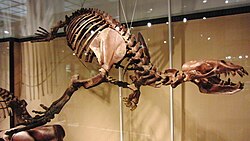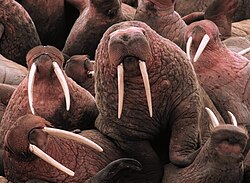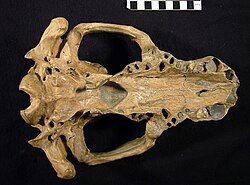species of pinnipeds and 102 species of fossil pinnipeds and their stem-relatives (Pinnipedimorpha), collectively referred to as pinnipedimorphs. Scientists...
28 KB (2,067 words) - 19:15, 25 March 2025
of arctoid carnivorans are the closest relatives to the pinnipedimorphs, being more closely related to musteloids. Below is an overall phylogeny of the...
6 KB (403 words) - 02:08, 11 December 2023
Drassonax (category Fossil taxa described in 1953)
Drassonax is an extinct genus of small, weasel-like bear. It lived in North America during the Early Oligocene, around 33 Ma. "†Drassonax Galbreath 1953...
799 bytes (39 words) - 23:52, 4 November 2024
Amphicynodontinae are classified as stem-pinnipeds in the superfamily Phocoidea. Fossils of these mammals have been found in Europe, North America and Asia. Amphicynodontines...
7 KB (619 words) - 01:27, 7 January 2025
Kamtschatarctos (category Pinnipeds of Europe)
is an extinct genus of pinniped that lived approximately 15.97 to 11.608 mya during the Early Miocene in the Kavran-Ukhtolok Bay of Russia's Kamchatka...
2 KB (161 words) - 22:35, 1 April 2025
Hadrokirus (category Fossils of Peru)
Hadrokirus is an extinct genus of true seal (Phocidae) that lived on the coast of Peru and North Carolina about 6 million years ago. The type species,...
2 KB (166 words) - 03:13, 5 May 2025
fixed. Conservation status codes listed follow the International Union for Conservation of Nature (IUCN) Red List of Threatened Species. Range maps are...
58 KB (1,942 words) - 01:41, 5 May 2025
Desmatophoca (category Fossil taxa described in 1906)
the Oligocene, but without fossil samples obtained from this era, this is based primarily on conjecture. All samples of fossil Desmatophoca were found in...
9 KB (1,150 words) - 05:29, 4 January 2024
Amphicticeps (category Fossil taxa described in 1924)
journal}}: CS1 maint: numeric names: authors list (link) Morlo, Michael; Nagel, Doris (2006). "The carnivore guild of the Taatsiin Gol area: Hyaenodontidae (Creodonta)...
15 KB (1,183 words) - 18:34, 2 August 2024
Pachyphoca (category Fossil taxa described in 2013)
moving bottom preys. I. A. Koretsky and S. J. Rahmat. 2013. First record of fossil Cystophorinae (Carnivora, Phocidae): Middle Miocene seals from the northern...
3 KB (229 words) - 04:38, 28 May 2025
phylogeny and fossil record integration". Evolution. 78 (7): 1212–1226. doi:10.1093/evolut/qpae061. Berta, Annelisa. "Encyclopedia of Marine Mammals...
3 KB (258 words) - 15:04, 24 May 2025
polyphyletic group of marine mammals, a few points of cranial and dental morphology suggested that the otarioids originated from a line of bears. One extinct...
3 KB (262 words) - 15:03, 29 January 2025
Titanotaria (category Fossil taxa described in 2018)
preserved fossil walrus currently known. Although the holotype specimen (OCPC 11141) of Titanotaria had been discovered in 1993 and represents one of the most...
10 KB (992 words) - 15:11, 24 May 2025
Pontolis (category Fossil taxa described in 1905)
2020). "Insights on the Dental Evolution of Walruses Based on New Fossil Specimens from California". Journal of Vertebrate Paleontology. 40 (5): e1833896...
4 KB (349 words) - 22:30, 27 May 2025
Pliopedia (category Fossil taxa described in 1921)
by Robert Anderson, and consists of pieces of both forelimbs. Known Pliopedia fossils include a humerus, pieces of radius and ulna from both forelimbs...
2 KB (140 words) - 01:13, 5 November 2024
Platyphoca (category Fossil taxa described in 1876)
is known from Pliocene marine deposits in the Antwerp region of Belgium, while fossils of P. danica have been found in the Tortonian-age Gram Formation...
1 KB (113 words) - 16:03, 3 October 2023
Monotherium (category Fossil taxa described in 1874)
is an extinct genus of phocid belonging to the subfamily Monachinae. It is known from fossils found in the middle to late Miocene of Belgium. The type and...
2 KB (217 words) - 00:39, 5 November 2024
Pteronarctos (category Fossil taxa described in 1988)
Pteronarctos is a genus of basal pinnipediform from middle Miocene marine deposits in Oregon. Two species of Pteronarctos are known, P. goedertae and P...
2 KB (176 words) - 20:16, 18 November 2024
Amphicynodon (category Fossils of France)
Amphicynodon was an extinct genus of caniform carnivore. It has traditionally been considered an early bear, although recent evidence has suggested it...
3 KB (135 words) - 00:20, 2 May 2025
Imagotaria (category Fossil taxa described in 1968)
extinct monotypic genus of walrus with the sole species Imagotaria downsi. Fossils of Imagotaria are known from the early late Miocene of California (c. 10-12...
3 KB (365 words) - 23:29, 4 November 2024
Puijila (category Fossil taxa described in 2009)
Puijila, a very basal 'pinnipedimorph'. Ed Yong, Puijila, the walking seal — a beautiful transitional fossil. "Fossil seal had the feet of an otter" by Bob...
7 KB (636 words) - 01:19, 5 November 2024
Enaliarctos (category Fossil taxa described in 1973)
Enaliarctos is an extinct genus of pinnipedimorph, and may represent the ancestor to all pinnipeds. The five species in the genus Enaliarctos have been...
5 KB (501 words) - 19:49, 18 November 2024
Pontophoca (category Fossil taxa described in 1941)
while fossils of P. jutlandica have been found in the Tortonian-age Gram Formation in Denmark. I. Koretsky. 2001. Morphology and systematics of Miocene...
1 KB (115 words) - 17:25, 24 May 2021
Gryphoca (category Fossil taxa described in 1876)
is known from Pliocene marine deposits in the Antwerp region of Belgium, while fossils of P. nordica have been found in the Tortonian-age Gram Formation...
2 KB (124 words) - 09:51, 23 February 2024
Kolponomos (category Fossil taxa described in 1960)
discovery of more fossils including a nearly complete cranium from the original locality of K. clallamensis which helped identify it as part of the group...
9 KB (944 words) - 04:44, 21 November 2024
Proneotherium (category Miocene mammals of North America)
lacked the long tusks of walruses, and were more slender and smaller than their modern relatives. Autapomorphies of Proneotherium fossils include a continuous...
3 KB (259 words) - 08:38, 18 November 2024
Potamotherium (category Fossil taxa described in 1833)
Analysis of fossils suggests that Potamotherium had a poor sense of smell, but made up for this with good vision and hearing. Fossils of Potamotherium...
7 KB (728 words) - 02:50, 3 March 2025
Frisiphoca (category Fossil taxa described in 2018)
extinct genus of phocid belonging to the subfamily Phocinae. It is known from fossils found in the late Miocene of Belgium. There are two species of Frisiphoca...
2 KB (191 words) - 18:08, 24 May 2021
Homiphoca (category Fossil taxa described in 1980)
genus of earless seals from the Pliocene of South Africa. The type species of Homiphoca, H. capensis, was originally described as a species of the dubious...
3 KB (272 words) - 20:34, 12 February 2024
Praepusa (category Fossil taxa described in 1941)
Netherlands, is notable for being the smallest fossil seal, with a size comparable to the smallest extant seals of the genus Pusa. The other species include...
5 KB (434 words) - 15:35, 25 May 2025

















